Atlas of radiographic features of osteoarthritis of the ankle and hindfoot
- PMID: 26318654
- PMCID: PMC4663119
- DOI: 10.1016/j.joca.2015.08.008
Atlas of radiographic features of osteoarthritis of the ankle and hindfoot
Abstract
Objective: To develop a radiographic atlas of osteoarthritis (OA) for use as a template and guide for standardized scoring of radiographic features of OA of the ankle and hindfoot joints.
Method: Under Institutional Review Board approval, ankle and hindfoot images were selected from a cohort study and from among cases that underwent ankle radiography during a 6-month period at Duke University Medical Center. Missing OA pathology was obtained through supplementation of cases with the assistance of a foot and ankle specialist in Orthopaedic surgery and a musculoskeletal radiologist. Images were obtained and reviewed without patient identifying information. Images went through multiple rounds of review and final images were selected by consensus of the study team. For intra-rater and inter-rater reliability, the kappa statistic was calculated for two readings by three musculoskeletal radiologists, a minimum of two weeks apart, of ankle and hindfoot radiographs from 30 anonymized subjects.
Results: The atlas demonstrates individual radiographic features (osteophyte and joint space narrowing (JSN)) and Kellgren-Lawrence grade for all aspects of the talocrural (ankle joint proper) and talocalcaneal (subtalar) joints. Reliability of scoring based on the atlas was quite good to excellent for most features indicated. Additional examples of ankle joint findings are illustrated including sclerosis, os trigonum, subchondral cysts and talar tilt.
Conclusions: It is anticipated that this atlas will assist with standardization of scoring of ankle and hindfoot OA by basic and clinical OA researchers.
Keywords: Ankle; Atlas; Hindfoot; Osteoarthritis; Radiograph; Subtalar.
Copyright © 2015 Osteoarthritis Research Society International. Published by Elsevier Ltd. All rights reserved.
Conflict of interest statement
No authors have any conflict of interest or competing interests with respect to this work.
Figures

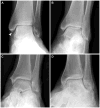
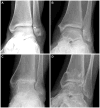


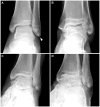
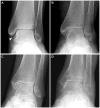
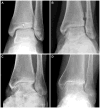
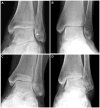
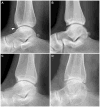



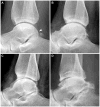
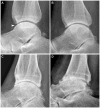
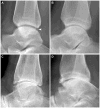





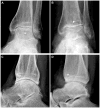
Similar articles
-
Radiographic evaluation of posttraumatic osteoarthritis of the ankle: the Kellgren-Lawrence scale is reliable and correlates with clinical symptoms.Osteoarthritis Cartilage. 2015 Mar;23(3):363-9. doi: 10.1016/j.joca.2014.11.010. Epub 2014 Nov 15. Osteoarthritis Cartilage. 2015. PMID: 25463444
-
Characteristic Bone Morphology Change of the Subtalar Joint in Severe Varus Ankle Osteoarthritis.J Foot Ankle Surg. 2022 May-Jun;61(3):627-632. doi: 10.1053/j.jfas.2021.10.026. Epub 2021 Oct 29. J Foot Ankle Surg. 2022. PMID: 34823970
-
Validating a new computed tomography atlas for grading ankle osteoarthritis.J Foot Ankle Surg. 2015 Mar-Apr;54(2):207-13. doi: 10.1053/j.jfas.2014.06.017. Epub 2014 Aug 16. J Foot Ankle Surg. 2015. PMID: 25135101
-
Pseudo os trigonum sign: missed posteromedial talar facet fracture.Foot Ankle Int. 2003 Aug;24(8):642-9. doi: 10.1177/107110070302400813. Foot Ankle Int. 2003. PMID: 12956572 Review.
-
Lateral ankle and hindfoot instability: a new clinical based classification.Foot Ankle Surg. 2014 Dec;20(4):231-6. doi: 10.1016/j.fas.2014.05.003. Epub 2014 May 17. Foot Ankle Surg. 2014. PMID: 25457657 Review.
Cited by
-
Lower Limb Deformity and Gait Deviations Among Adolescents and Adults With X-Linked Hypophosphatemia.Front Endocrinol (Lausanne). 2021 Sep 27;12:754084. doi: 10.3389/fendo.2021.754084. eCollection 2021. Front Endocrinol (Lausanne). 2021. PMID: 34646241 Free PMC article.
-
Relationship of Joint Hypermobility with Ankle and Foot Radiographic Osteoarthritis and Symptoms in a Community-Based Cohort.Arthritis Care Res (Hoboken). 2019 Apr;71(4):538-544. doi: 10.1002/acr.23686. Arthritis Care Res (Hoboken). 2019. PMID: 29953742 Free PMC article.
-
Defining multiple joint osteoarthritis, its frequency and impact in a community-based cohort.Semin Arthritis Rheum. 2019 Jun;48(6):950-957. doi: 10.1016/j.semarthrit.2018.10.001. Epub 2018 Oct 9. Semin Arthritis Rheum. 2019. PMID: 30390991 Free PMC article.
-
Correlation of Fracture Energy With Sanders Classification and Post-traumatic Osteoarthritis After Displaced Intra-articular Calcaneus Fractures.J Orthop Trauma. 2019 May;33(5):261-266. doi: 10.1097/BOT.0000000000001432. J Orthop Trauma. 2019. PMID: 30640298 Free PMC article.
-
Clinical Assessment and Management of Foot and Ankle Osteoarthritis: A Review of Current Evidence and Focus on Pharmacological Treatment.Drugs Aging. 2019 Mar;36(3):203-211. doi: 10.1007/s40266-019-00639-y. Drugs Aging. 2019. PMID: 30680680 Review.
References
Publication types
MeSH terms
Grants and funding
LinkOut - more resources
Full Text Sources
Other Literature Sources
Medical

